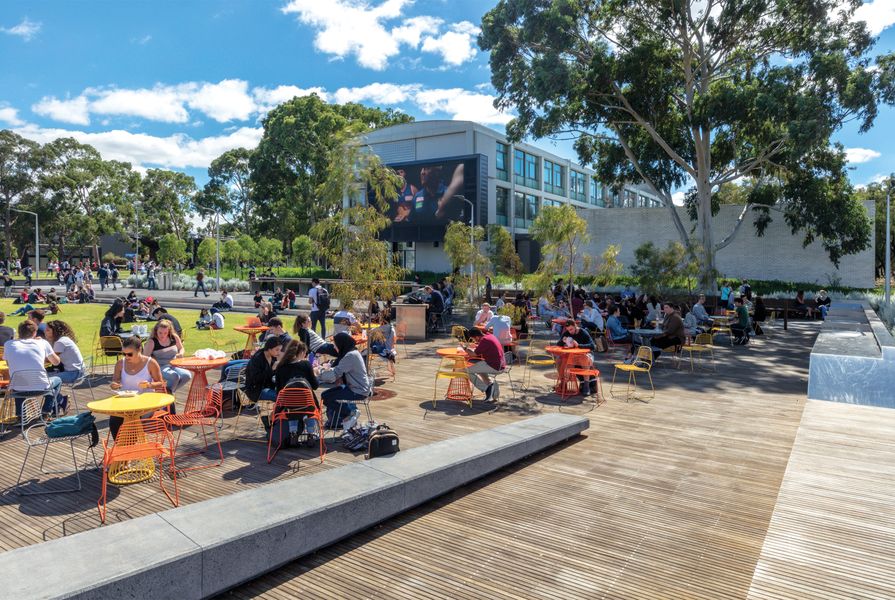“Precinct” is the word on all city-makers’ lips these days. It has snuck into job titles, government department names and awards categories. Much more than a collection of buildings and urban spaces, today’s precincts represent large units of collaboration and are increasingly being used by the government, institutions and the private sector to transform areas in an integrated way. The word’s increased use reflects a government imperative to think about city-making at a broader scale, to capture more value, to improve a project’s risk profile and to integrate public benefits through urban renewal.
However, the list of precincts that have underdelivered for their cities is long. Precinct design and delivery is often performed in an uncoordinated way: either left to the market to resolve, in a procurement process that precludes proper dialogue with stakeholders or consultation with end users, or rushed through to meet the compressed timelines of developer-led bid processes. As a result, the outcomes of these large urban projects are often poor-quality, disjointed urban environments that fail to deliver value for the broader community. Development for the sake of it is not enough. As urban designers, we need to deliver neighbourhoods that are integrated “pieces of city” – with affordable housing, parks, biodiversity corridors, public transport and cultural centres alongside private housing and office space.
The upstream toolkit
The design of integrated neighbourhoods requires time for strategic thinking, and testing of design and development scenarios, before the project brief is fixed. By operating in an expanded capacity through this phase of precinct conception, urban designers and architects can dramatically improve outcomes by guiding clients through the long-term impacts of decisions they might not even think of as design. These include critical decisions about financial structures, approaches to delivery, and governance and procurement processes – all of which fundamentally determine the design possibilities, and the human and ecosystem outcomes, of precincts.
An “upstream toolkit” is essential for anyone collaborating on precinct-scale urban change. As architects and designers, we need to integrate the following steps into our processes to ensure that a project is set on the right trajectory from the beginning:
Build literacy around successful precincts with decision-makers
A cohesive precinct is only possible when the client sees itself as a custodian and understands the interrelationships between the commercial proposition (the deal), the precinct design and its own ongoing governance beyond the delivery phase. We have a duty to take our clients on an educational journey; this might include study tours, interviews, benchmarking and post-occupancy reviews of other relevant precincts. We need to find our champions and ensure that design thinking is central to their role. Literacy must be built and maintained with senior decision-makers and project sponsors in both the boardroom and the field.
Design the deal
The way a precinct development comes to market determines much of what is possible in terms of design. We have an important role in explaining to the client the long-term impacts of procurement, risk-sharing and go-to-market strategies (including capital raising, sales and leasing strategies), and how these affect yield and long- term community benefits. The architecture of this transaction is just as important as the actual design and can have lasting consequences downstream.
Initiate and host the dialogue
A place cannot be transformed by one person or one institution alone. Part of our role is the active recruitment of precinct stakeholders, both current and future, to bring together government, institutions, businesses and community in the early phases of the development. Too often, this process is reduced to a risk-management exercise and outsourced to arms-length specialists, rather than being recognized as a valuable co-design opportunity. Through forums large and small, public and private, we can build alliances and long-term governance models in a spirit of openness, transparency and collaboration to enhance the chances of political buy-in and precinct success.
Craft a specific vision
A precinct vision brings together the aspirations of the client, the city and the future inhabitants with the specific DNA of that place in order to balance public and private interests. This vision needs to be simple and compelling but unique, robust and achievable. While plans inevitably evolve, a well-crafted vision endures, defining parameters that safeguard the essence of a precinct’s ambition. As much time and emphasis is required for this phase of the design process as for the spatial strategy.
Plan with operational realities
Too often, precincts are thought of as “projects” rather than “places.” This emphasis focuses on the three to five years it takes to build the precinct, rather than the 100-plus years that people will be living, working, studying and playing there. By helping the client determine who will manage and curate the precinct over time, how this will be funded, how change will be managed and how maintenance will be carried out, we not only create a precinct that functions better but achieve a more sustainable outcome, environmentally and socially.
Set the brief
Writing a brief is a design task in itself. An effective brief spells out clearly the ambitions for the project, who will be involved, how long it will take and how it will be delivered. A design-led brief must be prepared with intimate awareness of the spatial consequences of an instruction, informed by reference designs and feasibility studies. This provides an important starting point for the design team – both at the masterplan scale, and then for each ensemble, building and space within.
Develop a design governance strategy
In the same way that the architecture of a transaction predetermines outcomes, so does the design procurement and governance approach, which must include the right combination and scale of competitions, effective pairings of design offices, quality teams, design review panels, citizen juries and other strategies. This heightened scrutiny is necessary to grasp opportunities for innovation at each phase, to allow for carefully mediated flexibility, and to maintain vision throughout a precinct’s delivery phase. Design governance has made great gains in the past decade across Australia, influenced significantly by CABE (now the Design Council) in the UK.
The toolkit in action
Successful use of this toolkit is evident across a broad range of precinct types, from institutional clients (such as universities) to government- and private-sector-led projects.
Over the past decade, Monash University’s Clayton campus in Melbourne’s south-eastern suburbs has been transformed. What was a tired, vehicle-dominated, modernist site, suffering from ad hoc investment in fragmented, faculty-specific projects, has become a vibrant university city within an exceptional landscape. A long-term masterplan – concerned as much with organizational as spatial design and supported by new governance instruments to guide briefing, procurement and review of projects – has allowed for a successful place strategy. Countless projects have been awarded for excellence in urban design, architecture and landscape architecture.
Representing a coordinated effort by the university, urban designers MGS Architects and the design team for each project, this transformation has relied on the commitment and investment of the university’s leaders in the campus vision. The establishment of a masterplan delivery team and a design review panel, alongside the engagement of a tenured university architect, has enabled curation to continue over time. The university’s sophisticated management of the built environment has led to a strong rapport with the government and an emerging vision for an expanded Monash Technology Precinct as an intermediary city in Melbourne supported by major transport investment.
In contrast to the singular control of a university, King’s Cross Central in the heart of London is an example of a public-private partnership. In the 1990s, the area was an unloved expanse of disused railway tracks and industrial buildings. Today, framed at either end by redeveloped stations, it incorporates 2,000 new homes (50 percent of which are affordable), 20 restored heritage buildings, shops, offices and well-loved temporary activations such as the King’s Cross Pond Club. In this case, an enduring partnership between government and the developer, Argent, who shared a vision for King’s Cross to feel like a “piece of London,” has sustained the curation of the precinct over a 20-year period.
London’s King’s Cross Central is an example of a complex, multi-stakeholder urban renewal project that balances private investment imperatives with an extensive and generous public realm stitched into the surrounding city.
Image: Crookesmoor, CC BY-SA 4.0
Argent was committed to understanding the challenge before asking architects to design anything. The company’s then-CEO, Roger Madelin, cycled around, speaking to 7,500 different people in 353 different meetings. The masterplan, by Allies and Morrison with Porphyrios Associates, established a flexible framework, robust enough to evolve over time (including through an economic downturn). More than the buildings themselves, it focused on ensuring that the spaces between the buildings were right. King’s Cross is now one of London’s more sought-after places to live, work and visit, anchored by Central St Martins art school, Google’s UK HQ and a network of well-activated public spaces used by people from across the city.
A call to action for the next generation of precinct leaders
As precinct development becomes an increasingly significant tool for urban transformation in Australian cities, it is vital that designers engage with the upstream processes to create the preconditions for success. Our skills of analysis, iterative testing, synthesis of ideas, storytelling and visual communication are indispensable in this process. While we might look to northern Europe for inspiration in ecologically ambitious precinct development, there is a history within Australian cities of designers engaging in this role – but it is rarely celebrated.
Through our respective practices, we have learned that much of this knowledge is held in the minds of individuals working within this space, but little is documented or transferred in a systematic way. We need to invest in building a talent pool of future leaders who are armed with the skills to execute excellence in precinct development.
In the face of the climate emergency, biodiversity decline, housing stress and social isolation, our model for delivering new pieces of city must deliver much more. This is our opportunity to shift the conversation from the short-term sugar hit of land sales toward long-term public value in every new neighbourhood.


















